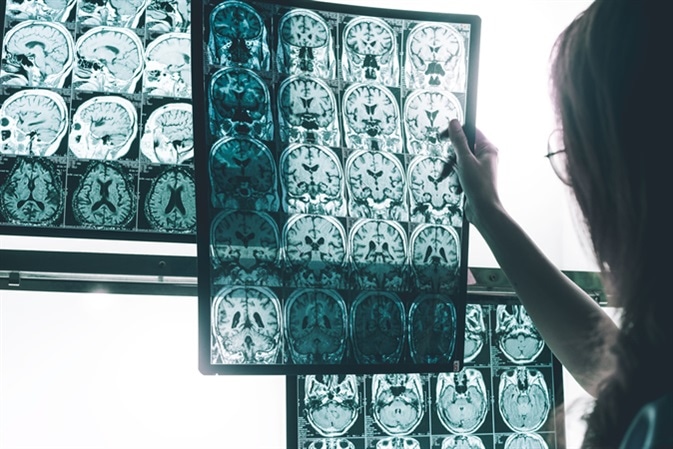
Integrated PET/MR for Alzheimer’s Disease
Written by Lois Zoppi, BA., reviewed by Angela Betsaida B. Laguipo, BSN
PET/MR imaging is used for monitoring and assessing brain function, molecular information and metabolism. Combined PET/MR imaging has improved the diagnostic power for Alzheimer’s disease, enabling early and accurate diagnoses and better elimination of differential diagnoses. Combining PET and MR scans is a convenient option for patients which also lowers the amount of radiation they are exposed to.

Alzheimer's disease on MRI. Image Credit: Atthapon Raksthaput / Shutterstock
What is Alzheimer’s Disease?
Alzheimer’s disease is a common cause of dementia, a term used for a group of symptoms that include memory loss and difficulties with cognitive tasks such as problem-solving. As Alzheimer’s progresses, proteins build up in the brain and form neurofibrillary tangles and β-amyloid plaques (Aβ plaques). These structures result in connections between nerve cells being lost and the death of nerve cells and brain tissue. The number of chemicals responsible for transmitting signals around the brain are also depleted, meaning signals are not transmitted effectively through the brain.
Risk factors for Alzheimer’s disease are age, obesity, diabetes, and infections or inflammation in the brain.
PET Imaging
PET is a nuclear medicine procedure, meaning a small amount of radioactive material, also known as a radiopharmaceutical, radiotracer or radionuclide, is used to evaluate a particular organ’s metabolism.
MR Imaging
MR imaging uses a magnetic field and radio waves. Contrast materials administered intravenously are sometimes used to enhance the images produced by the scan.
What is Hybrid PET/MR?
PET/MR is a test combining positron emission tomography (PET) scan and magnetic resonance imaging (MRI) scan. It combines the advanced soft tissue contrast and imaging parameters of MR and the high sensitivity of PET.
MR imaging uses tissue characterization with enhanced soft tissue contrast, providing structural and functional information of the brain. MR imaging easily distinguishes between cerebral gray matter and white matter and presents the brain tissue in a 3D form. PET imaging provides the molecular and metabolic information of the brain. PET accurately charts the distribution of the tangles and plaques present in Alzheimer’s disease.
There is potential for PET/MR to be used for diagnostic classification, identifying disease stages, providing an understanding of Alzheimer’s disease pathomechanisms and also in evaluating prognosis.
Benefits of PET/MR for Alzheimer’s Disease
Combining PET and MR scans mean that patients do not have to commit to more than one scan. It also reduces the radiation burden for patients compared to those receiving positron emission tomography-computed tomography (PET-CT) scans.
Head motion can interfere with PET images but is sometimes difficult to avoid in patients with neurologic disorders. Combined PET/MR scans may mean using optical tracking equipment to correct head motion is no longer necessary.
According to a recent study, PET/MR can benefit patients with Alzheimer’s disease. It has unique benefits to improve the early and differential diagnosis. This is done through the combination of molecular and metabolic information from PET scan, and the functional and structural information from MR scan.
Risks of PET/MR for Alzheimer’s Disease
As with any medical procedure, there are a number of identified risks, including:
- Exposure to radiation in small amounts suitable for diagnostic purposes.
- Rare and mild allergic reactions to radiopharmaceuticals used in nuclear medicine procedures.
- Risks to pregnant and breastfeeding women.
- Mild pain or discomfort when the radionuclide is injected intravenously
Insulin, tranquilizers, sedatives and other medications may have a negative impact on the accuracy of a PET scan, along with the consumption of tobacco, caffeine, and alcohol, and high blood glucose levels in patients with diabetes.
Conclusion
Integrated PET/MR imaging for Alzheimer’s disease has proved to benefit diagnostic, prognostic and classification purposes and also increases practical convenience for patients by cutting down the number of appointments they need to attend. While PET/MR imaging does pose certain risks including radiation exposure and rare allergic reactions, its ability to provide accurate and early diagnosis of Alzheimer’s disease means that better treatment can be provided for a disease that currently lacks an effective treatment plan to stop or slow its progression.
Sources
- http://iopscience.iop.org/article/10.1088/0031-9155/42/10/010/pdf
- www.alzheimers.org.uk/about-dementia/types-dementia/alzheimers-disease
- www.ed.ac.uk/.../pet-mri
- www.hopkinsmedicine.org/.../positron_emission_tomography_pet_92,P07654
- https://www.ncbi.nlm.nih.gov/pmc/articles/PMC5672108/
- https://www.radiologyinfo.org/en/info.cfm?pg=bodymr
- https://www.radiologyinfo.org/en/info.cfm?pg=pet#benefits-risks
- https://www.ncbi.nlm.nih.gov/pmc/articles/PMC5672108/
Further Reading
Last Updated: Aug 14, 2018






















.png)









No hay comentarios:
Publicar un comentario